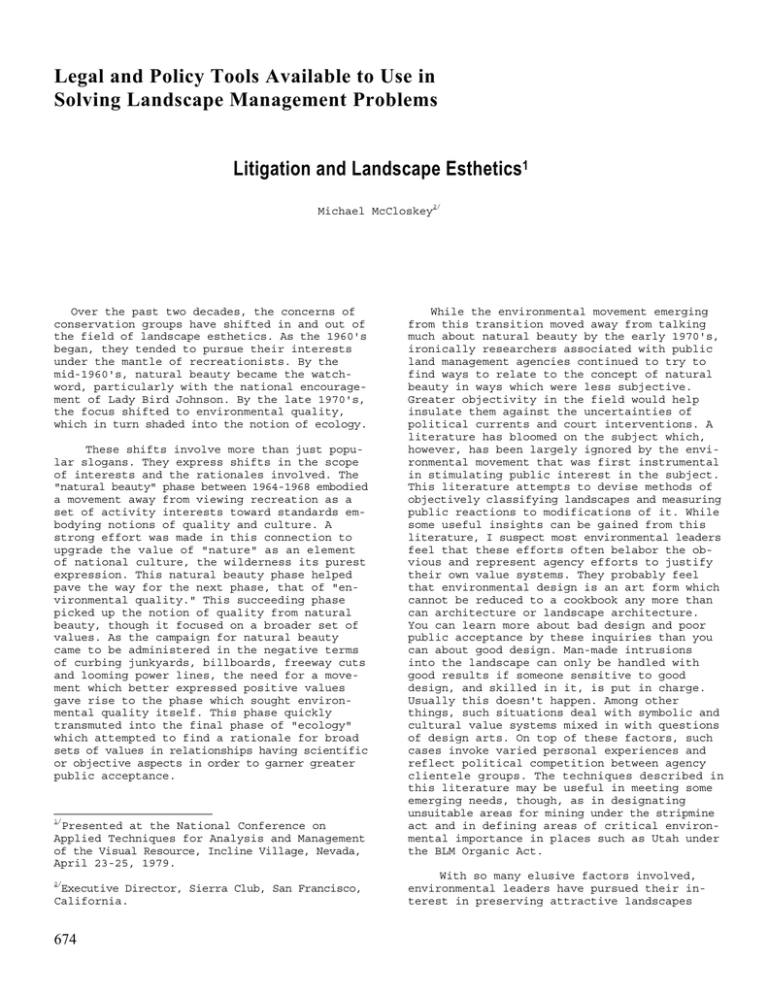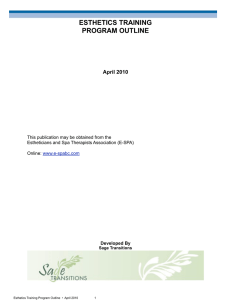Legal and Policy Tools Available to Use in
advertisement

Legal and Policy Tools Available to Use in Solving Landscape Management Problems Litigation and Landscape Esthetics1 Michael McCloskey Over the past two decades, the concerns of conservation groups have shifted in and out of the field of landscape esthetics. As the 1960's began, they tended to pursue their interests under the mantle of recreationists. By the mid-1960's, natural beauty became the watchword, particularly with the national encouragement of Lady Bird Johnson. By the late 1970's, the focus shifted to environmental quality, which in turn shaded into the notion of ecology. These shifts involve more than just popular slogans. They express shifts in the scope of interests and the rationales involved. The "natural beauty" phase between 1964-1968 embodied a movement away from viewing recreation as a set of activity interests toward standards embodying notions of quality and culture. A strong effort was made in this connection to upgrade the value of "nature" as an element of national culture, the wilderness its purest expression. This natural beauty phase helped pave the way for the next phase, that of "environmental quality." This succeeding phase picked up the notion of quality from natural beauty, though it focused on a broader set of values. As the campaign for natural beauty came to be administered in the negative terms of curbing junkyards, billboards, freeway cuts and looming power lines, the need for a movement which better expressed positive values gave rise to the phase which sought environmental quality itself. This phase quickly transmuted into the final phase of "ecology" which attempted to find a rationale for broad sets of values in relationships having scientific or objective aspects in order to garner greater public acceptance. 1/ Presented at the National Conference on Applied Techniques for Analysis and Management of the Visual Resource, Incline Village, Nevada, April 23-25, 1979. 2/ Executive Director, Sierra Club, San Francisco, California. 674 2/ While the environmental movement emerging from this transition moved away from talking much about natural beauty by the early 1970's, ironically researchers associated with public land management agencies continued to try to find ways to relate to the concept of natural beauty in ways which were less subjective. Greater objectivity in the field would help insulate them against the uncertainties of political currents and court interventions. A literature has bloomed on the subject which, however, has been largely ignored by the environmental movement that was first instrumental in stimulating public interest in the subject. This literature attempts to devise methods of objectively classifying landscapes and measuring public reactions to modifications of it. While some useful insights can be gained from this literature, I suspect most environmental leaders feel that these efforts often belabor the obvious and represent agency efforts to justify their own value systems. They probably feel that environmental design is an art form which cannot be reduced to a cookbook any more than can architecture or landscape architecture. You can learn more about bad design and poor public acceptance by these inquiries than you can about good design. Man-made intrusions into the landscape can only be handled with good results if someone sensitive to good design, and skilled in it, is put in charge. Usually this doesn't happen. Among other things, such situations deal with symbolic and cultural value systems mixed in with questions of design arts. On top of these factors, such cases invoke varied personal experiences and reflect political competition between agency clientele groups. The techniques described in this literature may be useful in meeting some emerging needs, though, as in designating unsuitable areas for mining under the stripmine act and in defining areas of critical environmental importance in places such as Utah under the BLM Organic Act. With so many elusive factors involved, environmental leaders have pursued their interest in preserving attractive landscapes through other methods. They did not want to be trapped into a position of trying to justify values which would look like elitist judgments. In fact, tastemakers in our culture with respect to the landscape have always been tied closely to intellectuals and artists. Their tastes and traditions gradually influence popular reactions through the medium of education. However, environmental leaders believe that it is far wiser to regulate manipulation of the landscape through environmental regulations than through esthetic regulations. Reclamation under the Surface Mine Reclamation Control Act will in fact minimize the ugliness caused by strip mining for coal. By requiring that high walls be eliminated, that the original contour in hilly country be restored and by planting native vegetation, all sorts of environmental problems will be dealt with (erosion, acid drainage, access for migrating wildlife, etc.). In the process esthetic problems will also be incidentally minimized. But there will be no need to argue with an industry or agency about the esthetics of highwalls. They will just be eliminated. The National Forest Management Act of 1976 flatly requires that limits be placed on the size of clear cuts, rather than leaving us with an endless argument over the relative esthetics of massive clear-cutting. The Clean Air Act amendments of 1977 require that visibility in Class I airsheds, subject to the requirement for the "prevention of significant deterioration," be maintained according to definite standards. A continuing argument over social preferences among southern Utah residents for extended visibility is not pursued. Such arguments would be no more enlightening than surveying the reactions of people to junkyards or slaughtering plants. Those who make their livings in such facilities will probably find a way to bend their normal instincts to rationalize a tolerance for them, but most people will not react that way. In fact, I would tend to argue that it is more likely that good environmental housekeeping will produce acceptable aesthetic results than conversely. In most cases, detailed environmental regulations in the field of surface mining for coal, for instance, will produce a reasonably attractive landscape. However, landscape programs alone will not protect the public from toxic leachate from copper mine tailings ponds nor from radioactive vegetation on attractively regraded and planted uranium mine tailings. Moreover, a debate over the esthetics of tailing pile landscaping can divert attention from less visible but more insidious problems of this sort. I personally witnessed an example of this problem last summer in connection with a review of the status of copper mining south of Tucson, Arizona, by the National Academy of Science. Too much time was taken up debating whether the screening of the tailing piles was adequate for those who could see them from a nearby retirement center, and almost no time was spent on reviewing the state of knowledge about possible contamination of the aquifer with heavy metals leaching out of the tailing ponds. In almost every case, there are physical and biological handles on environmental problems that present far better opportunities for remedial action than the esthetic ones. And I would submit that when these non-esthetic handles are used to affect a remedy, much of the esthetic problem will also be reduced. Environmental law has tended to follow the changing overall strategies of the environmental movement. Litigation has illuminated questions at the cutting edge of controversy. However, esthetics have not tended to be at the cutting edge of environmental controversy because both the general strategies have moved away from questions of esthetics and litigation is not well suited to deal with a subject matter which inherently is so subjective. Litigation in the field of public law depends on demonstrating that agencies have either failed to stay within a legally mandated boundary line or have failed to cross it when they were required to. In cases of injunctive relief, the plaintiffs most often must show that discretion has been abused through arbitrary and capricious behavior. This is particularly hard to show when dealing with a question as subjective as esthetics. About the only clear grounds for a suit based upon esthetics would be in a case where the agency had a duty to consider esthetic factors and made no record whatsoever showing it had done so in a professional manner, or where an EIS did not even discuss esthetics. The question is most likely to draw attention in future litigation when a federal reservation is established primarily for esthetic reasons (possibly NRA's) and the compatibility of developmental activity is in question (e.g., mining and housing). But here the outcome will likely turn on the exact phraseology used in the statute on the question of compatibility. An agency is likely to get sued on questions of esthetics only when it has a clear responsibility to pay some attention to such questions and totally neglects to do so. Otherwise, the matter is likely to get addressed largely through legislation establishing a regulatory regime designed to produce a result which meets more objective environmental criteria but incidentally also produces an attractive landscape. 675




